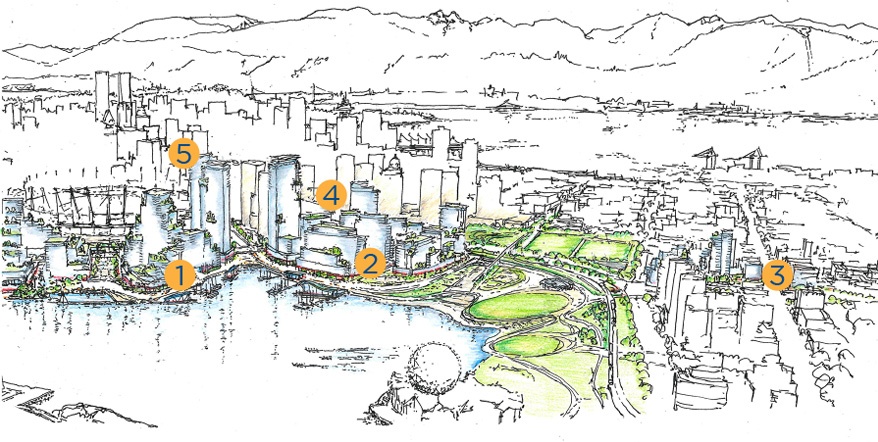We identified a list of emerging priorities for public benefits by consulting with the community and reviewing community needs.
The Northeast False Creek Plan will ensure that public amenities and services continue to meet the community’s needs as the area grows and evolves.
The timing and delivery of public benefits in Northeast False Creek depend on rezoning applications from landowners.

Summary of public amenities and services
Public benefits are grouped by development area. Each area is numbered on the illustration above.
1. Sub-area 6B
- Social housing (20% of residential floor area)
- Childcare facility
- Covered/open plaza (Plaza of Nations)
- Arts pavilion
- Community centre including seniors’ space and ice rink
- Artist production space
- Public art
2. Sub-area 6C
- Social housing (20% of residential floor area)
- Creekside Park extension, Dunsmuir Connection, Georgia Landing and Wharf
- Childcare facility
- Non-motorized boating support facility
- Community policing centre
- Artist production space
- Public art
3. Sub-area 6D
- 300 social housing units (including for First Nations post-secondary students, Chinese seniors, and families)
- Childcare facility
- Cultural centre
- Non-profit office space
- Social impact assessment mitigation and monitoring
- Artist production space
- Public art
4. Sub-area 7A
- Secured market rental units as approved by City Council in 2012
5. Sub-area 10C
- Public amenity contribution already delivered through Stadium Upgrade Agreement Concourse
- Connection with Georgia Street
Off-site
- Viaducts removal, new street network, and critical infrastructure
- Secure six option sites for social housing
- Andy Livingstone Park and Creekside Park renewal
- Firehall #8 renewal and expansion on option sites
- Heritage contribution
- Non-profit cultural space
- Contribution toward Firehall #1 and #2 replacement/expansion
How amenities are funded
Amenities are delivered from a variety of sources using different tools. We provide funds for childcare facilities, parks, community centres, libraries, cultural facilities, affordable housing, utility upgrades (water and sewer), and street improvements.
Funding for public amenities comes through the coordinated allocation of funds from the following:
- Property taxes, utility fees, and user fees
- Contributions related to development
- Other levels of government
- Non-profit partners
